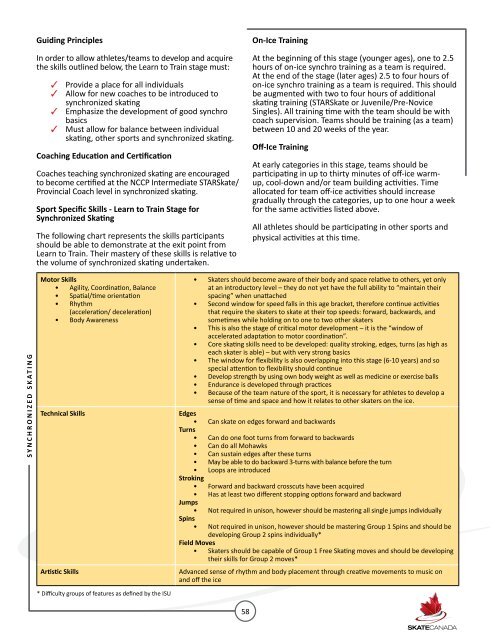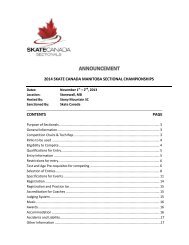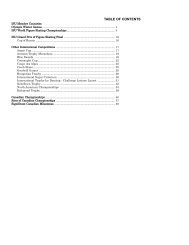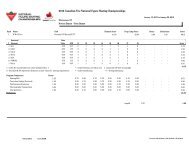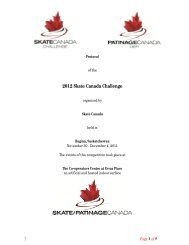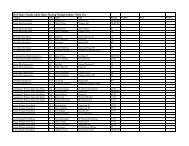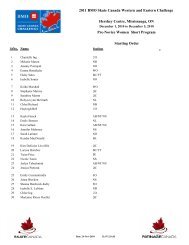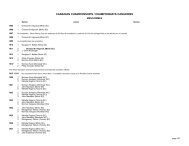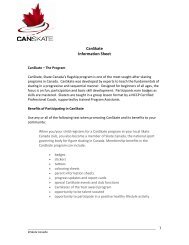LONG-TERM ATHLETE DEVELOPMENT - Skate Canada
LONG-TERM ATHLETE DEVELOPMENT - Skate Canada
LONG-TERM ATHLETE DEVELOPMENT - Skate Canada
Create successful ePaper yourself
Turn your PDF publications into a flip-book with our unique Google optimized e-Paper software.
S Y N C H R O N I Z E D S K A T I N G<br />
Guiding Principles<br />
In order to allow athletes/teams to develop and acquire<br />
the skills outlined below, the Learn to Train stage must:<br />
3 Provide a place for all individuals<br />
3 Allow for new coaches to be introduced to<br />
synchronized skating<br />
3 Emphasize the development of good synchro<br />
basics<br />
3 Must allow for balance between individual<br />
skating, other sports and synchronized skating.<br />
Coaching Education and Certification<br />
Coaches teaching synchronized skating are encouraged<br />
to become certified at the NCCP Intermediate STAR<strong>Skate</strong>/<br />
Provincial Coach level in synchronized skating.<br />
Sport Specific Skills - Learn to Train Stage for<br />
Synchronized Skating<br />
The following chart represents the skills participants<br />
should be able to demonstrate at the exit point from<br />
Learn to Train. Their mastery of these skills is relative to<br />
the volume of synchronized skating undertaken.<br />
Motor Skills<br />
• Agility, Coordination, Balance<br />
• Spatial/time orientation<br />
• Rhythm<br />
(acceleration/ deceleration)<br />
• Body Awareness<br />
Phone 613.747.1007 I Toll Free 1.888.747.2372 I Fax 613.748.5718 I Toll Free Fax 1.877.211.2372<br />
58<br />
On-Ice Training<br />
At the beginning of this 865 Sheord stage (younger Road, Ottawa, ages), Ontario one K1J to 1H9 2.5<br />
hours of on-ice synchro training as a team is required.<br />
At the end of the stage (later ages) 2.5 to four hours of<br />
on-ice synchro training as a team is required. This should<br />
be augmented with two to four hours of additional<br />
skating training (STAR<strong>Skate</strong> or Juvenile/Pre-Novice<br />
Singles). All training time with the team should be with<br />
coach supervision. Teams should be training (as a team)<br />
between 10 and 20 weeks of the year.<br />
Off-Ice Training<br />
At early categories in this stage, teams should be<br />
participating in up to thirty minutes of off-ice warmup,<br />
cool-down and/or team building activities. Time<br />
allocated for team off-ice activities should increase<br />
gradually through the categories, up to one hour a week<br />
for the same activities listed above.<br />
All athletes should be participating in other sports and<br />
physical activities at this time.<br />
• <strong>Skate</strong>rs should become aware of their body and space relative to others, yet only<br />
at an introductory level – they do not yet have the full ability to “maintain their<br />
spacing” when unattached<br />
• Second window for speed falls in this age bracket, therefore continue activities<br />
that require the skaters to skate at their top speeds: forward, backwards, and<br />
sometimes while holding on to one to two other skaters<br />
• This is also the stage of critical motor development – it is the “window of<br />
accelerated adaptation to motor coordination”.<br />
• Core skating skills need to be developed: quality stroking, edges, turns (as high as<br />
each skater is able) – but with very strong basics<br />
• The window for flexibility is also overlapping into this stage (6-10 years) and so<br />
special attention to flexibility should continue<br />
• Develop strength by using own body weight as well as medicine or exercise balls<br />
• Endurance is developed through practices<br />
• Because of the team nature of the sport, it is necessary for athletes to develop a<br />
sense of time and space and how it relates to other skaters on the ice.<br />
Technical Skills Edges<br />
• Can skate on edges forward and backwards<br />
Turns<br />
• Can do one foot turns from forward to backwards<br />
• Can do all Mohawks<br />
• Can sustain edges after these turns<br />
• May be able to do backward 3-turns with balance before the turn<br />
• Loops are introduced<br />
Stroking<br />
• Forward and backward crosscuts have been acquired<br />
• Has at least two different stopping options forward and backward<br />
Jumps<br />
• Not required in unison, however should be mastering all single jumps individually<br />
Spins<br />
• Not required in unison, however should be mastering Group 1 Spins and should be<br />
developing Group 2 spins individually*<br />
Field Moves<br />
• <strong>Skate</strong>rs should be capable of Group 1 Free Skating moves and should be developing<br />
their skills for Group 2 moves*<br />
Artistic Skills Advanced sense of rhythm and body placement through creative movements to music on<br />
and off the ice<br />
* Difficulty groups of features as defined by the ISU


